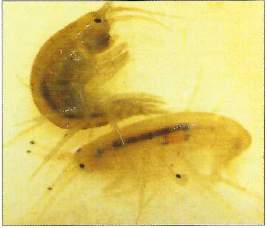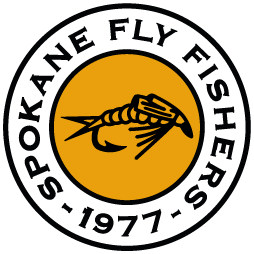The Baggie Shrimp is one of the Pacific Northwest’s best scud patterns. The lower scud image displays the prominent orange marsupium or egg pouch, where it gets it’s name. (webmaster note: the following pictures do not go where I want them, so do your best to go follow along.)

Materials:
Hook: Tiemco 2457 or 3769, #8-#16
Thread: Olive 6.0 or 8/0
Rib: Fine copper wire
Shellback: 1/8” wide Scud Back or plastic strip
Body: Seal’s fur or substitute
Marsupium: Hot Orange Dubbing
Reproduced from the book Fly Patterns for Stillwaters by Phil Rowley, with permission. Submitted by Rolf Marsh
Tying Steps:

Step 1. Debarb hook and weight shank if so desired. Cover the hook shank with thread.

Step 2. Tie in rib material and return thread to eye of hook.

Step 3. Take an 1/8” inch wide Scud Back or plastic strip for the
shellback and cut one end to a point like a picket fence.

Step 4. Tie in the prepared plastic strip at the eye of the hook, on top of the hook shank. The balance of the material should point out over the eye of the hook. Return the tying thread to the rear of the hook.

Step 5. Form a dubbing noodle and dub the main body color to the mid-point on the hook.

Step 6. Dub a small ball of hot orange dubbing to form the marsupium, 2 to 3 wraps is sufficient.

Step 7. With the marsupium in place continue dubbing the main body color forward to the eye.

Step 8. Take a half turn of the rib so the copper wire is hanging straight down below the hook point. Pull the shellback along the top of the fly and secure in place by winding the rib material forwards to the eye. The width of the shellback can be altered by the amount of tension applied to it. Tie off ribbing material and break of excess. Trim the shellback even with the bend of the hook. Hold the scissors’ points on a 30-40 degree angle away from the hook bend pointing rearward. Trimming the shellback in this manner creates a “V” like tail imitating the scuds telson. (last segment in the abdomen) Build a neat head, whip finish and apply head cement. Roughen the body and trim to a scud shape. Place a dab of red nail polish on the eye to identify a weighted fly.
